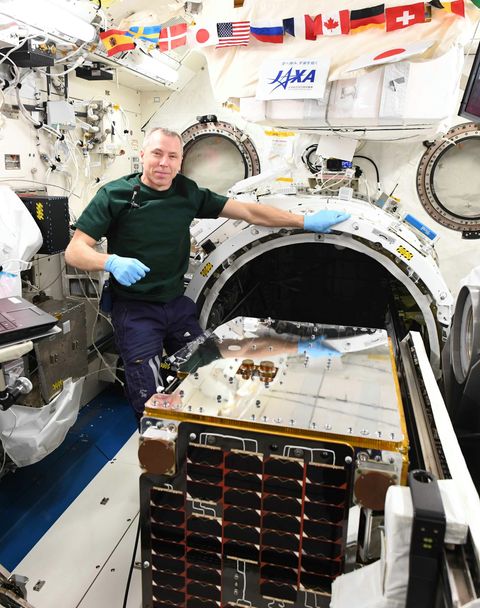RemoveDEBRIS spacecraft launched from ISS with Airbus space debris capture removal technology

Airbus net, vision based navigation, and harpoon experiments will deploy in orbit
Toulouse/Stevenage/Bremen, 20/06/2018 - The space debris removal technology mission RemoveDEBRIS, led by the Surrey Space Centre (SSC) at the University of Surrey, has been launched into orbit from the International Space Station (ISS). RemoveDEBRIS will demonstrate a range of innovative technologies to clean up space debris, with the first Airbus designed and built experiment due for deployment in October 2018.
The spacecraft features three Airbus technologies to perform Active Debris Removal (ADR): a net and a harpoon to capture debris, and also a Vision Based Navigation (VBN) system to develop rendezvous techniques in orbit with space debris. The spacecraft itself was designed and built by Airbus subsidiary Surrey Satellite Technology Limited (SSTL) and also includes a drag sail to speed up deorbiting of the whole mission.
The mission timelines will see the net deployed in October this year, followed by the VBN test in late December and then the harpoon in February 2019. The experiments will all be carried out below the orbit of the ISS.
The net experiment, developed by Airbus in Bremen, will see a cubesat deployed from the main mission craft. When the cubesat is 5 metres away, it will then be targeted by the net and captured at approximately 7 metres before it floats away to deorbit.
The VBN system from Airbus in Toulouse will test 2D cameras and a 3D LIDAR (light detection and ranging) technology supplied by CSEM to track a second cubesat deployed from the main spacecraft. The VBN system will track its rotation and movement away from the main spacecraft. At the same time the cubesat will transmit its true position to the main spacecraft, enabling the performance of the VBN to be measured. This cubesat will then float and deorbit naturally.
The Airbus Stevenage designed harpoon will see a 1.5 metre boom deployed from the main spacecraft with a piece of composite panel on the end. The harpoon will be fired at 20 metres/sec to penetrate the target and demonstrate the ability of a harpoon to capture debris.
Nicolas Chamussy, Head of Airbus Space Systems said: “We have spent many years developing innovative active debris removal systems to be at the forefront of tackling this growing problem of space debris and to contribute to the UNs’ Sustainable Development Goals for our future generations. We will continue to work closely with teams across the world to make our expertise available to help solve this issue.”
After completion of the Airbus designed ADR, the main spacecraft will deploy the drag sail developed by SSC which will deorbit the craft in approximately 8 weeks. Without the drag sail, deorbiting would take more than 2.5 years.
Co-funded by the European Commission under FP7, RemoveDEBRIS is an international collaboration between the University of Surrey, Airbus, Ariane Group, Surrey Satellite Technology Ltd, Innovative Solutions In Space, CSEM (Switzerland); Inria (France) and Stellenbosch University.
This Space Station satellite deployment opportunity was made possible thanks to NanoRacks and its Space Act Agreement with NASA’s U.S. National Labs.
***
Video https://www.youtube.com/watch?v=4ZFAkBMtcPo
Notes to Editors:
The project is co-funded by the European Commission and the research leading to the results have received funding from the European Union Seventh Framework Program (FP7/2007-2013) under grant agreement n°607099.
About Airbus
Airbus is a global leader in aeronautics,space and related services. In 2017 it generated revenues of € 59 billion restated for IFRS 15 and employed a workforce of around 129,000. Airbus offers the most comprehensive range of passenger airliners from 100 to more than 600 seats. Airbus is also a European leader providing tanker, combat, transport and mission aircraft, as well as one of the world's leading space companies. In helicopters, Airbus provides the most efficient civil and military rotorcraft solutions worlwide.
Your contact
Ralph Heinrich
AIRBUS | Defence and Space
Francisco Lechón
External Communications - Airbus Space Systems, Spain
Jeremy Close
AIRBUS | Defence and Space
Guilhem Boltz
AIRBUS | Defence and Space